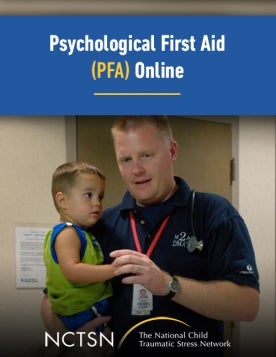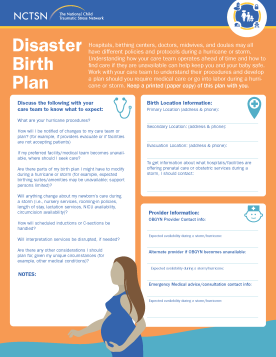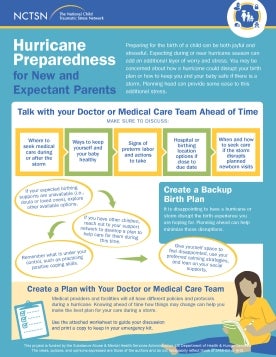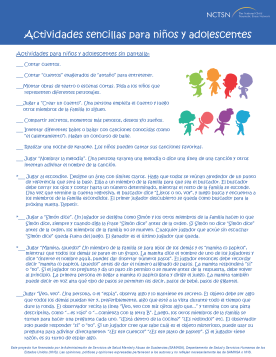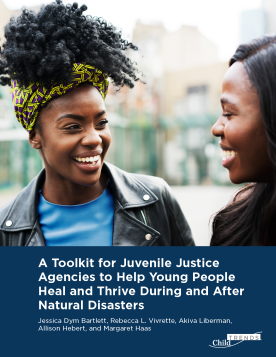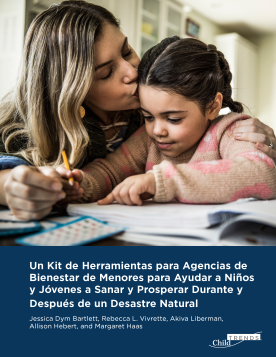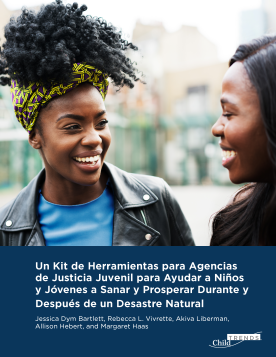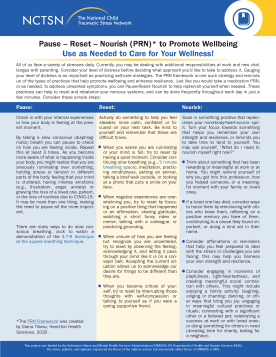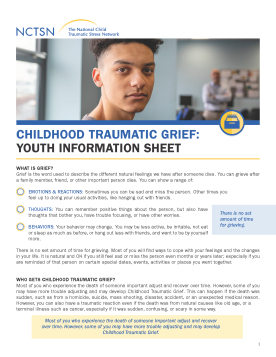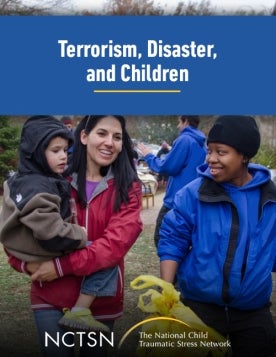A hurricane is a large, rotating tropical storm with powerful wind and heavy rains that can cause storm surges, flooding, mudslides, and tornadoes. Hurricanes gather heat and energy through contact with warm ocean waters, and the most severe weather is around the eye of the storm, which can be up to thirty miles wide. A hurricane can last more than two weeks and can travel up the entire length of the eastern coast. Hurricanes usually occur between June 1 through November 30 in the Atlantic Ocean, with August and September being the peak months. These storms are called typhoons in the Northwest Pacific and cyclones in the South Pacific and Indian Ocean. Hurricanes affect entire communities, often with extensive damage.
Being prepared beforehand is the best way to help children and family members recover after a hurricane. Communities prone to hurricanes are encouraged to get their residents prepared before the hurricane season begins. Hurricanes are often tracked for weeks before reaching land, providing early warnings and time to prepare. To improve their preparedness, families should:
- Be informed about their hurricane risk, how to access updated hurricane information, and whether their property is insured. Families should know their risk for flooding and best evacuation routes; what official radio stations, websites, and/or social media will provide hurricane updates; and whether or not they have adequate flood insurance. Encourage families to contact their communities’ emergency preparedness office if they have any members who have ongoing health concerns or if they will need assistance during evacuations. Help families to understand the different hurricane alerts:
- Hurricane Watch: Hurricane conditions are possible in the watch area within the next 36 hours.
- Hurricane Warning: Hurricane conditions are expected in the warning area within 24 hours.
- Coastal Flood Watch: The possibility exists for the inundation of land areas along the coast within the next 12 to 36 hours.
- Coastal Flood Warning: Land areas along the coast are expected to become—or have become—inundated by seawater above the typical tide action.
- Assemble an emergency go kit. Families should have access to enough water, food, and other emergency supplies for at least 3 days and medications for at least 7 days. Families should also include copies of important documents, a radio with batteries to get weather updates, and supplies for pets. Keep supplies in a large backpack, duffel bag, or easy to carry container in the event the family has to evacuate quickly. Children can also pack their own kits and include their favorite toys. Review the family preparedness plan for additional guidance.
- Prepare their property. Families should regularly trim trees and shrubs around their homes and clear rain gutters and downspouts.
- Make a family communication plan. Families should have important contact information easily accessible and know whom they might stay with in the event that they need to evacuate. Make sure babysitters are also aware of this plan. As a family, fill out the preparedness wallet card.
- Plan for children’s needs. Families should give children factual information about hurricanes in simple terms. Encourage parents to include children in preparedness activities. The Help Kids Cope app provides parents with tips for how to talk with children of different developmental levels.
Knowing what to do right before and during a hurricane can help families feel more in control and take steps to increase their safety. Parents and caregivers should consider the following when responding to a hurricane.
During a hurricane watch, families should:
- Stay informed about hurricane alerts and current weather updates.
- Check that their emergency supplies are updated and implement preparedness plans. Activities should include having enough food and water, contacting individuals they plan to stay with if evacuated, and securing their property.
- Monitor their risk and evacuate as needed. Families should follow all evacuation instructions from local authorities. Families should consider evacuating if they live in an area prone to flooding or have a family member that may be affected by being without power for an extended period (e.g., health issues, very young children).
During an evacuation, families should:
- Gather their emergency go kit, all loved ones, and pets in their car. If they are using shared transportation, identify the pickup areas and make sure the route to that location is safe. Families should also communicate with someone outside the storm area about where they are going.
- Seek updated information on evacuation conditions. Families should check to see if any evacuation routes are blocked and what traffic congestion exists.
- Secure animals and leave property secured. Families should implement a plan for pets and livestock if they cannot evacuate as well and turn off utilities if instructed to do so.
- Locate a designated public shelter if needed. Families can text SHELTER and their zip code to 43362 (4FEMA) to find the nearest open shelter. They can also download the American Red Cross Shelter Finder app.
- Remain evacuated until authorities say it is safe to return.
If sheltering in place during the storm, families should:
- Monitor weather reports or check alerts to track the progress of the storm. Families should wait for official messages that the hurricane has passed before going outside.
- Extend food and water supplies. Families can maximize their supplies by keeping the refridgerator and freezer as cold as possible and only opening when necessary. Families can also store drinking water in clean bathtubs, jugs, bottles, and cooking pots.
- Be prepared to evacuate as needed.
To address children’s reactions during a hurricane, parents and caregivers can:
- Model calm behavior. Children may mirror the reactions of adults around them and will learn ideas for how to take care of themselves from what parents and caregivers do.
- Provide simple but accurate information in a steady voice.
- Encourage comforting or distracting activities. Children may benefit from doing slow breathing to calm their bodies, having a stuffed animal or blanket to hold, or being distracted from the storm by dancing, singing, or playing games. View these handouts for some ideas.
- Practice their own self-care. Parents and caregivers may benefit from finding opportunities to take a moment for themselves, express their feelings, acknowledge that it is a scary situation, and engage in a coping strategy.
After a hurricane, most families will recover over time, particularly with the support of family, friends, and organizations. The length of recovery depends, in part, on how frightened people were and the extent of the damage and loss in the community. Some families will be able to return to their normal routines rather quickly, while others will have to contend with repairing damage to their home and possessions, finding medical care, needing new employment, moving to a new community, and facing financial hardship. Some families will have lost a loved one or pet. Others will face multiple moves, and children may experience multiple placements in school.
Children will react differently to hurricanes depending on their age, developmental level, and prior experiences. Some typical reactions children may exhibit after a hurricane include the following:
-
Concerns about safety: Children may worry about another hurricane or fear that regular summer storms will create significant devastation. They may also be anxious about being separated from their loved ones.
-
Changes in behavior: Children can become clingy towards their parents or caregivers, have an increased activity level, experience difficulty concentrating or paying attention and become frustrated when they can’t remember something, and/or withdraw from others or stop participating in activities they previously enjoyed doing.
-
Expression of physical ailments: Children may complain of headaches, stomachaches, or general pain.
-
Changes in school/work performance and overall wellness: Children may show dramatic academic changes, such as changes in attendance and general functioning at school or work. They also may show changes in sleep, exercise, and their diet (e.g., what they eat and how much they eat).
Children’s functioning and recovery will be influenced by how their parents and caregivers cope after the hurricane. Children often turn to adults for information, comfort, and help. To assist children, discuss with parents and caregivers ways to:
-
Model how they handle stressful situations in front of their children.
-
Provide accurate information to their children about what happened during the storm as well as what changes the family is facing. Answer questions honestly but with the amount of detail appropriate to their developmental level.
-
Give themselves their own time to process what is happening.
-
Keep family routines as regular as possible, even in the early recovery phase.
-
Monitor the media and social media information children are viewing and set limits if children are overly focused on viewing this content.
-
Seek additional help for themselves or their children if behavioral changes or reactions worsen or if they persist over six weeks after the hurricane.
Below are additional resources to support children, families, and communities to recover after hurricanes.


